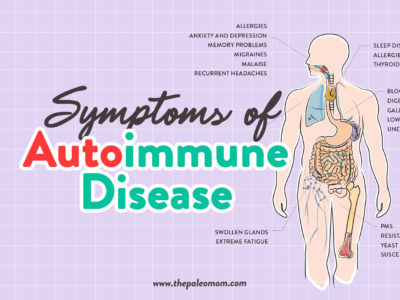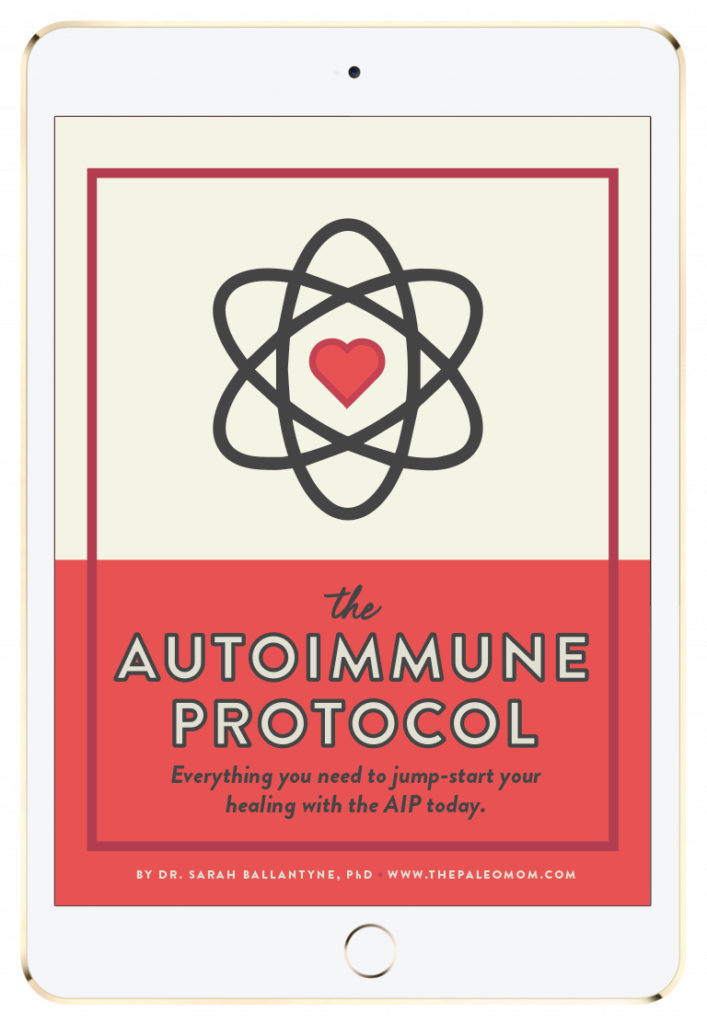There are more than one hundred confirmed autoimmune diseases and many more diseases that are suspected of having autoimmune origins, see Should Everyone Follow the AIP?. Symptoms of Autoimmune disease vary considerably, from the debilitating back pain of ankylosing spondylitis; to the loss of control over the body in multiple sclerosis; to the itchy, red, flaky skin of psoriasis. However, the root cause of all autoimmune diseases is the same: our immune system, which is supposed to protect us from invading microorganisms, turns against us and attacks our cells instead. Which cells or proteins are attacked determines the autoimmune disease and its symptoms.
Table of Contents[Hide][Show]
Autoimmune diseases may account for as much as half of all chronic diseases suffered by Americans today. The American Autoimmune Related Diseases Association (AARDA) estimates that 50 million Americans suffer from at least one autoimmune disease. In comparison, 12 million Americans suffer from cancer and 25 million from heart disease. These numbers are not only staggering in their own right, but the prevalence of autoimmune disease is increasing.
In addition, autoimmune disease is still greatly underdiagnosed, and the true number of people afflicted remains unknown. It is estimated, for example, that celiac disease has been diagnosed in only 5% of those who actually suffer from it. And, studies measuring the percentage of healthy individuals who have autoantibodies in their blood (antibodies that can attack their own cells) show that a staggering 20% to 30% of healthy people are potentially already in the very early stages of autoimmune disease (although the development of autoimmune disease requires more than just the formation of autoantibodies).
Why are there so many people out there struggling with autoimmune disease but not able to get an accurate diagnosis? This is due, in part, because autoimmune disease can be challenging to diagnose. Most of the time, there is no single test that can definitively determine whether you have an autoimmune disease. Rather, doctors must piece together clues from medical histories, symptoms of Autoimmune disease, physical exams, laboratory tests (most commonly blood tests), radiography results, and biopsies. Furthermore, autoimmune diseases often present as a collection of vague symptoms (such as fatigue, headaches, and muscle or joint aches). Other than experiencing these “minor” complaints, people may remain symptom-free for years or even decades, until the disease has progressed to the point at which the symptoms are severe, predictable, and fit into a pattern characteristic of the underlying autoimmune disease (at which point, diagnosis is more straightforward). And, too often these early symptoms are dismissed as signs of getting insufficient sleep, working too hard, stress, being over- or underweight, or age (see also Can You Really Be Healthy at Any Size?). In fact, a survey performed by AARDA showed that the majority of patients later found to have serious autoimmune conditions had a difficult time obtaining a diagnosis: 45% of them were labeled hypochondriacs in the earliest stages of their illnesses. a pattern consistent with a specific autoimmune disease.
So, let’s examine the symptoms common across many autoimmune diseases that may indicate it’s time to dig deeper with your healthcare provider (see TPV Podcast Episode 338: Integrative, Functional or Naturopathic?) and consider making some diet and lifestyle changes to better regulate the immune system, i.e., the Autoimmune Protocol.
Any of these symptoms can be associated with the early stages of autoimmune disease:
- Allergies (see also Paleo for Asthma and Allergies)
- Anxiety and depression (see also Paleo for Mental Health)
- Blood-pressure changes (usually low)
- Digestive problems
- Extreme fatigue
- Gallbladder disease (see also The Link Between Gallbladder Disease and Gluten Sensitivity)
- Low blood sugar
- Malaise (generally feeling unwell)
- Memory problems
- Migraines
- Muscle or joint pain
- Muscle weakness
- PMS
- Rashes and other skin problems (see also Paleo for Eczema)
- Recurrent headaches
- Resistance to weight loss
- Sleep disturbances
- Susceptibility to infections (see also Natural Approaches to Cold & Flu Season (and Covid-19!))
- Swollen glands
- Thyroid problems (see also The Link between the Thyroid and Infertility)
- Unexplained weight changes
- Yeast infections (see also TWV Podcast Episode 463: Is There Science Behind Candida Cleanses?)
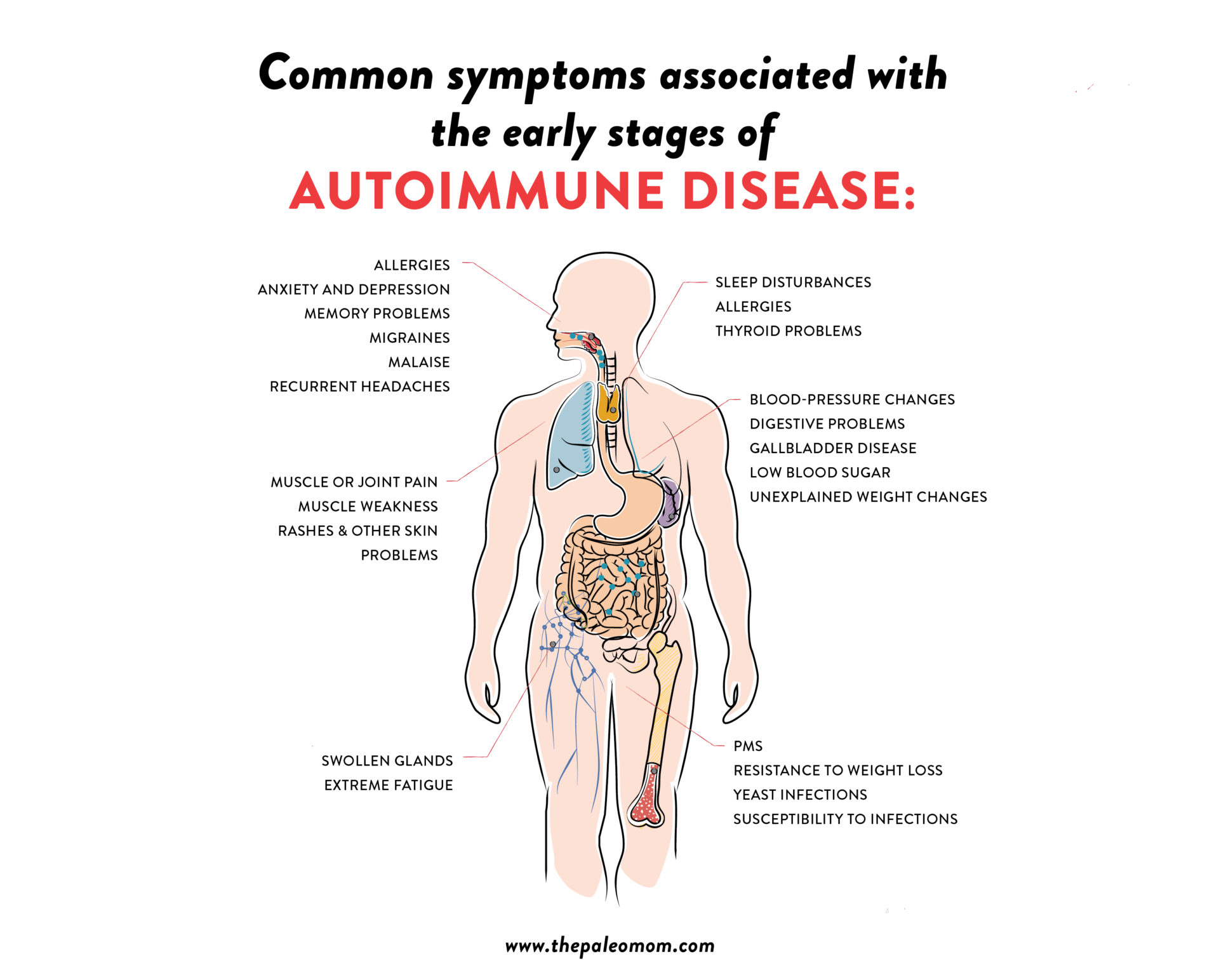
If you have any of these symptoms of Autoimmune disease, don’t panic—it doesn’t necessarily mean that you have or will develop autoimmune disease (there are other causes of each of these symptoms). However, if you are suffering from any of these symptoms, you don’t have to put up with the discomfort. All these symptoms can typically be alleviated with the diet and lifestyle changes in the Autoimmune Protocol. Most important, you have an opportunity—the opportunity to prevent autoimmune disease from developing!
Symptoms of the 12 Most Common Autoimmune Diseases
Wondering if your symptoms fit the pattern of an autoimmune disease? Below are the twelve most common autoimmune diseases along with prevalence and common symptoms. Note that for many autoimmune diseases, severity of symptoms can vary dramatically from person to person, and you may only experience one or two of the possible symptoms. For example, only a third of adults with celiac disease have gastrointestinal symptoms, and there’s even something called silent celiac disease in which there are no outward indicators.
Save 70% Off the AIP Lecture Series!
Learn everything you need to know about the Autoimmune Protocol to regain your health!
I am loving this AIP course and all the information I am receiving. The amount of work you have put into this is amazing and greatly, GREATLY, appreciated. Thank you so much. Taking this course gives me the knowledge I need to understand why my body is doing what it is doing and reinforces my determination to continue along this dietary path to heal it. Invaluable!
Carmen Maier
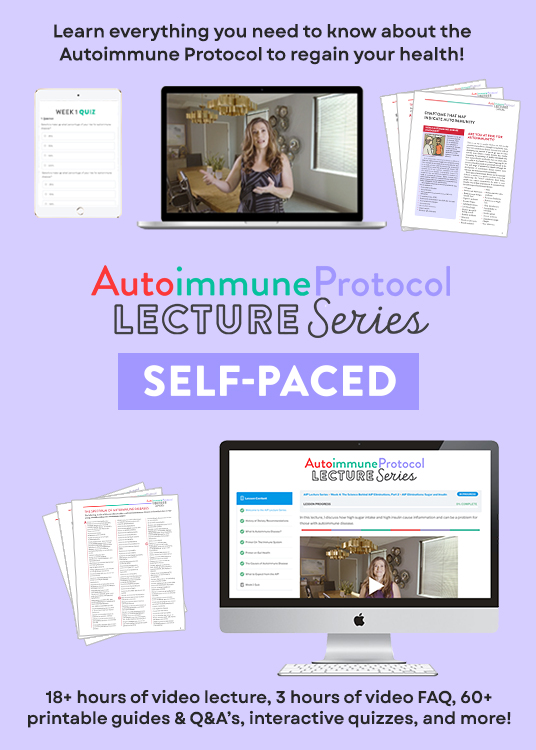
Sjögren’s syndrome: A systemic autoimmune disorder characterized by dry eyes and dry mouth.
Affects: up to 1 in 29 people
Symptoms: dry cough, dry eyes, dry skin, fatigue, joint stiffness, swollen lymph nodes, vaginal dryness and possibility of serious complications such as crippling fatigue, chronic pain, major organ involvement, neuropathies and lymphomas
Hashimoto’s thyroiditis: An autoimmune condition in which the thyroid does not make enough hormones for the body’s needs.
Affects: up to 1 in 34 people
Symptoms: dry or rough skin, hair loss, constipation, depression, enlarged thyroid, fatigue, joint stiffness, muscle weakness, puffy eyes, sensitivity to cold, slow heart rate, swelling in extremities, unexplained weight gain
Celiac disease: An autoimmune condition in which the small intestine is inflamed and damaged in response to eating gluten, a protein found in wheat, barley, and rye.
Affects: up to 1 in 53 people
Symptoms: abdominal pain, belching, diarrhea, steatorrhea (found-smelling, fatty, pale stools), heartburn, indigestion, nausea, vomiting, cramping, flatulence, joint pain, loss of bone density (osteopenia or osteoporosis), fatigue, malnutrition (anemia), delayed puberty, slow growth in children, itching, skin rash, weight loss, chronic fatigue, chronic migraine, peripheral neuropathy (tingling, numbness or pain in hands or feet), unexplained liver damage, unexplained infertility, depression and anxiety, eczema.
Alopecia areata: Sudden hair loss that starts with one or more circular bald patches that may overlap.
Affects: up to 1 in 59 people
Symptoms: hair loss, anxiety, itching, small dents in nails
Psoriasis: A condition in which skin cells build up and form scales and itchy, dry patches.
Affects: up to 1 in 65 people
Symptoms: rashes, dry skin, skin fissures, flaky skin, peeling skin, small bumps on skin, thickening skin, skin redness, joint pain, depression, inflamed tendons, joint stiffness, itching, small dents in nails
Type 1 diabetes: A chronic condition in which the pancreas produces little or no insulin.
Affects: up to 1 in 106 people
Symptoms: excessive thirst, fatigue, excessive hunger, excessive sweating, nausea or vomiting, excessive urination (bedwetting in children), blurred vision, elevated heart rate, headache, unexplained weight loss
Rheumatoid arthritis: A chronic inflammatory disorder affecting many joints, including those in the hands and feet.
Affects: up to 1 in 123 people
Symptoms: joint pain, back pain, joint stiffness, joint swelling, joint tenderness, joint weakness, muscle pain, fatigue, anemia, malaise, skin redness or lumps, swelling in fingers, dry mouth, physical deformity, sensation of pins and needles
Polymyalgia rheumatica: An inflammatory disorder causing muscle pain and stiffness around the shoulders and hips.
Affects: up to 1 in 135 people
Symptoms: shoulder pain, neck pain, pelvic girdle pain, joint stiffness, joint tenderness, fatigue
Grave’s disease: An autoimmune disorder that results in the overproduction of thyroid hormones.
Affects: up to 1 in 160 people
Symptoms: excess sweating, fatigue, heat intolerance, high blood pressure, elevated heart rate, irregular heart rate, heart palpitations, anxiety, nervousness, abnormal protrusion of eyes, puffy eyes, absence of menstruation, diarrhea, enlarged thyroid, hair loss, hand tremor, insomnia, irritability, muscle weakness, puffy skin changes on the shin, unexplained weight loss
Multiple sclerosis: A disease in which the immune system eats away at the protective covering of nerves.
Affects: up to 1 in 279 people
Symptoms: Pain in the back or eyes, tremor, muscle cramping, difficulty walking, inability to rapidly change motions, involuntary movements, muscle paralysis, muscle rigidity, muscle weakness, problems with coordination, stiff muscles, clumsiness, muscle spasms, overactive reflexes, fatigue, dizziness, heat intolerance, poor balance, vertigo, pins and needles, abnormality of taste, reduced sensation of touch, uncomfortable tingling and burning, excessive urination at night, leaking of urine, persistent urge to urinate, urinary retention, blurred vision, double vision, vision loss, erectile dysfunction, sexual dysfunction, anxiety, mood swings, difficulty speaking, slurred speech, constipation, depression, difficulty swallowing, difficulty thinking and understanding, headache, heavy legs, numbness of face, rapid involuntary eye movement, sleep deprivation, tongue numbness or weakness, difficulty raising the foot
Ulcerative colitis: A disease that causes inflammation and sores (ulcers) in the lining of the large intestine
Affects: up to 1 in 264 people
Symptoms: abdominal pain, rectal pain, bloating, cramping, blood in stool, constipation, diarrhea, inability to empty bowels, leaking of stool, urgent need to defecate, loss of appetite, joint pain, anemia, fatigue, fever, unexplained weight loss
Crohn’s disease: A type of inflammatory bowel disease (IBD) that may affect any part of the gastrointestinal tract.
Affects: up to 1 in 444 people
Symptoms: abdominal pain, rectal pain, bloating, cramping blood in stool, bowel obstruction, diarrhea, nausea, vomiting, flatulence, anal fissure, loss of appetite, mouth ulcer, joint pain, fatigue, fever, depression, slow growth in children, unexplained weight loss
Symptom Commonality Across Autoimmune Diseases
As you skimmed through the symptoms of Autoimmune diseases listed above, you may have noticed that some symptoms come up again and again (and again!) as being associated with autoimmune disease. The following are some of the most common autoimmune disease symptoms and those autoimmune diseases, just out of the dozen above, that may be behind them!
Skin Anomalies
- Sjögren’s syndrome
- Hashimoto’s thyroiditis
- Psoriasis
- Celiac disease
- Rheumatoid arthritis
- Grave’s disease
Fatigue
- Sjögren’s syndrome
- Hashimoto’s thyroiditis
- Celiac disease
- Type 1 diabetes
- Rheumatoid arthritis
- Polymyalgia rheumatica
- Grave’s disease
- Multiple sclerosis
- Ulcerative colitis
- Crohn’s disease
Muscle or Joint Pain
- Sjögren’s syndrome
- Celiac disease
- Psoriasis
- Rheumatoid arthritis
- Polymyalgia rheumatica
- Multiple sclerosis
- Ulcerative colitis
- Crohn’s disease
Headache
- Type 1 diabetes
- Multiple sclerosis
- Celiac disease
Gastrointestinal Symptoms
- Hashimoto’s thyroiditis
- Celiac disease
- Type 1 diabetes
- Grave’s disease
- Multiple sclerosis
- Ulcerative colitis
- Crohn’s disease
Depression, Anxiety or Malaise
- Hashimoto’s thyroiditis
- Celiac disease
- Psoriasis
- Rheumatoid arthritis
- Grave’s disease
- Multiple sclerosis
- Crohn’s disease
Why Isn’t this Information Mainstream?
A variety of factors contribute to the gulf between the sheer number of people affected by autoimmune disease and public awareness of it. Because there are no drugs that are effective at broadly treating autoimmune disease, pharmaceutical companies, generally a source of information about diseases, have no interest in generating information about autoimmune disease. And governments around the world—another source of information about health—still support nutritional guidelines that are already twenty years out of sync with biological, medical, and nutrition research. Public awareness might have to wait a while.
Another reason that autoimmune disease isn’t on most people’s radar is that it is not actually considered a class of diseases (the way cancer, for example, encompasses a variety of diseases or the way cardiovascular disease can refer to a variety of conditions). This is why there are no autoimmune disease specialists. Instead, you have to find a doctor whose expertise is the organ or system that is affected by your disease. So, although all these diseases have the same root cause, if you have arthritis, you see a rheumatologist; if you have hypothyroidism, you see an endocrinologist; if you have celiac disease, you see a gastroenterologist; and if you have psoriasis, you see a dermatologist.
Just as there are no physicians who specialize in autoimmune disease, autoimmune disease research is typically approached from the context of one specific autoimmune disease. There are very few research labs that focus on the commonalities between autoimmune diseases in the effort to identify a root cause. Epidemiological studies thus far have focused only on individual autoimmune diseases. But, this is starting to change. As researchers garner a more in-depth understanding of the root causes of autoimmune disease, and as this information percolates through the medical field and public knowledge, more and more people will learn what autoimmune diseases are and whether or not they have one.
In the meantime, consider making diet and lifestyle changes to improve health. The Autoimmune Protocol (AIP) is a complementary approach to chronic disease management focused on providing the body with the opportunity and nutritional resources required for immune regulation, gut health (which includes gut barrier, microbiome, gut-relevant hormones, digestion, and detoxification), hormone regulation and tissue healing while removing inflammatory stimuli from both diet and lifestyle. The AIP is not a substitute for your doctor, but instead is compatible with informed and judicious use of conventional medicine interventions, pharmaceuticals, and supplements, and fully embraces functional medicine.
Learn More About the AIP
I firmly believe that a thorough understanding of the details is key to utilizing the AIP successfully, whether adopting a more relaxed version for general health or adapting the AIP for non-autoimmune chronic illness. Understanding all of the symptoms of Autoimmune disease is a part of it.
Below, I’ve ordered my AIP educational resources geared at autoimmune disease sufferers and their caregivers from introductory quick-start to detailed deep-dive, as well as from independent to interactive.

Intro to AIP’ free e-mail series
I recently completely revamped my 15-part Intro to AIP e-mail series. This is a great starting point if you’re curious about the AIP but don’t feel the need to rush in (you’ll be delivered the e-mails over a month, but you’ll also get my AIP Quickstart Guide as a free download right away). You can sign up for the series here.

The Autoimmune Protocol e-book
With this all-in-one e-book, you’ll be able to hone in on the information that matters most, including 300+ pages of quick-access information on the AIP, new information on why nutrient sufficiency and gut health are a primary focus of the AIP, 4 weeks of meal plans with shopping lists, over 80 family-friendly recipes, and more! This is a great starting point if you want everything you need to jump right in all in one place, but without diving deep into the why’s. Get it here.
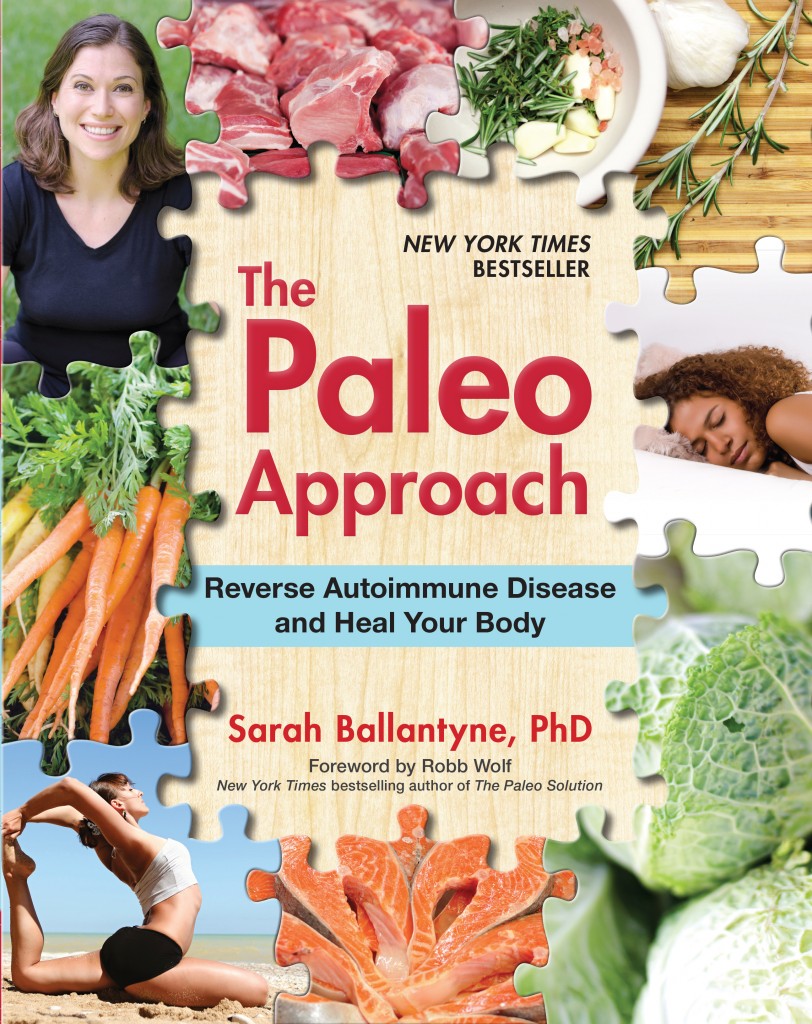
The Paleo Approach book
The Paleo Approach is the definitive guidebook on the Autoimmune Protocol. With over 400 pages of scientific explanations of the why’s, what’s, and how’s behind diet and lifestyle recommendations to help regulate the immune system and provide the body with the opportunity to heal. This encyclopedic resource also contains tons of practical information including tips for transitions, working with your doctor, medical test and treatments that might be helpful, troubleshooting, and when and how to reintroduce foods. This is a great starting point if you need to know the why’s to be motivated to make positive changes, or if you learn better reading an actual physical book (highlighters and postits welcome!). Get it here.

Therapeutic Paleo Approach online course
The Therapeutic Paleo Approach online course features 5 hours of video lecture that covers nutrient requirements of biological systems, prevalence and sources of nutrient deficiencies, top sources of nutrients commonly deficient, designing a nutrient-sufficient diet, sleep as a linchpin of health, impact of stress on health, activity balance and health, connection and health, links to the top mortality- and morbidity-causing chronic illnesses, and an introduction to the Autoimmune Protocol! This is a great starting point if you learn better with videos and visual guides than reading a book, and are looking for a broad overview with a positive what-to-eat focus. Get instant access here.

The AIP Lecture Series interactive online course
In this 6-week, video-based, intensive and interactive online course, I teach the scientific foundation for the diet and lifestyle tenets of the Autoimmune Protocol, plus provide tons of tips and strategies for implementation, refinement and troubleshooting! It’s also my opportunity to provide individualized guidance and support, and I connect with every single student within a private Facebook group for the course and answer every single question posed during the session.
This course is perfect if you learn better in an interactive, supportive multimedia environment, want to dive deep into the why’s, and want the most comprehensive understanding of the full AIP possible. I gear this course at all levels, from the person completely new to the AIP all the way to the seasoned pro who is looking to take their AIP to the next level.
You can learn more about the AIP Lecture Series here.

